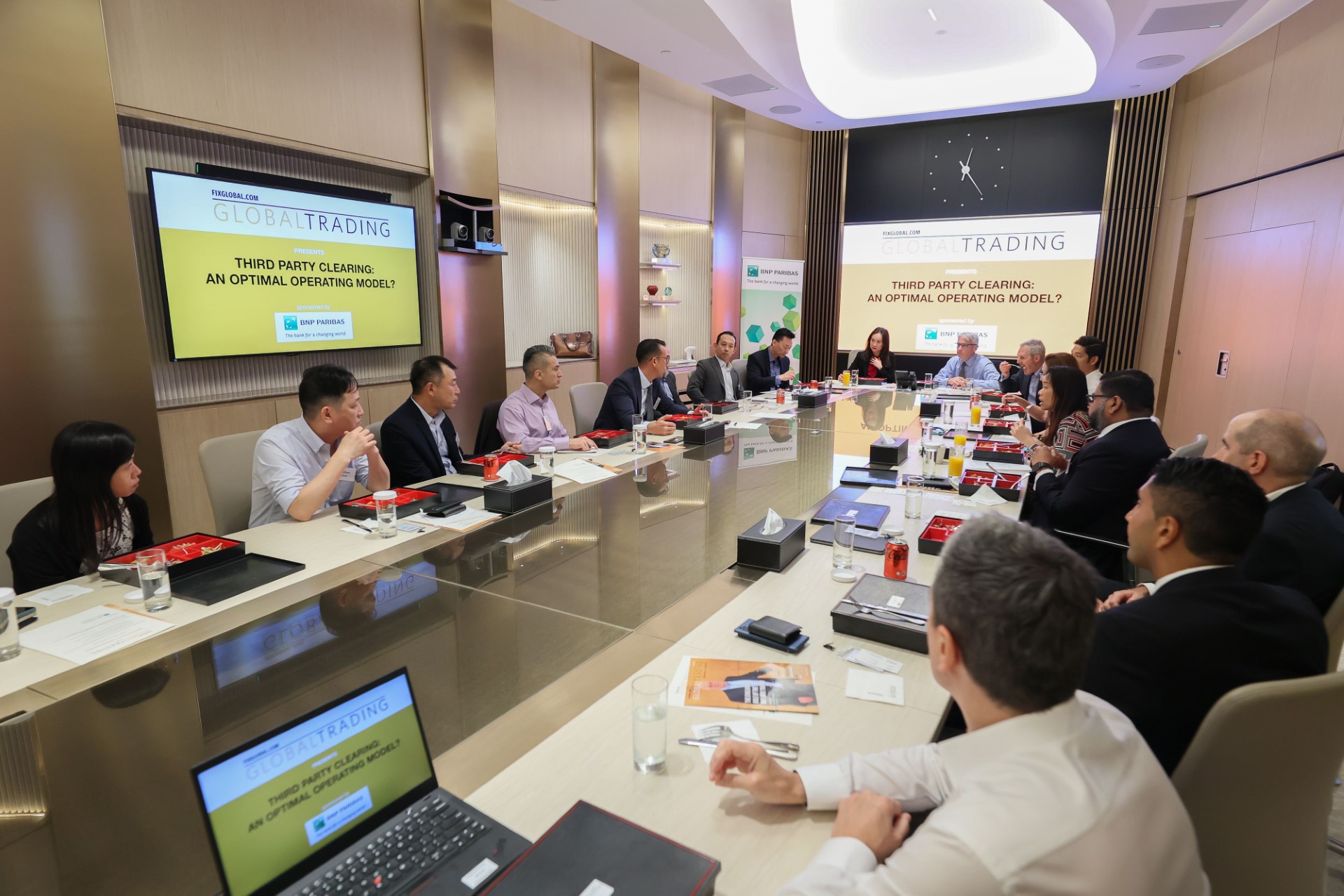Technology, capital and resilience requirements have brought a tipping point into view. Caption: GlobalTrading webinar in Hong Kong, hosted by BNP Paribas.
Caption: GlobalTrading webinar in Hong Kong, hosted by BNP Paribas.
A confluence of regulatory changes, increasing market activity new products and technical evolution has left back offices across Asia Pacific in search of an operating model that allows them to do more with less. This continues driving a steady shift towards third-party clearing (TPC) models in the region, revealed participants at a recent GlobalTrading roundtable held in Hong Kong titled Third Party Clearing: An Optimal Operating Model?
Sponsored by the Securities Services business of BNP Paribas, one of the region’s leading third-party clearers, a question posed at the roundtable was when TPC adoption in Asia Pacific might finally catch up to that of Europe, where the vast majority of equities clearing is outsourced.
The overwhelming sentiment at the roundtable was that the long-anticipated tipping point is now in sight owing to a challenging market environment that calls for greater efficiencies, along with the implementation of wide-ranging changes to the region’s market infrastructure that could bring it more in line with European markets.
In times like these, TPC not only provides capital efficiency and access to liquidity, but it also helps ensure that users are compliant with new regulations and able to accommodate the latest technologies.

Caption: Julien Kasparian, Head of Securities Services Hong Kong & Coverage Management APAC at BNP Paribas

Caption: Nina Tait, Head of HK & Greater China + APAC Prime Services Operations at Barclays
Technology is Key
“There are increasing demands from a compliance perspective, and brokers’ IT spend has to be in tandem with that – you have to be able to invest in technology,” noted Kathy Ong, Regional Product Manager, Custody and Clearing Services at BNP Paribas.
As noted during last year’s roundtable covering digital transformation of post trade, technology investment holds the key to overcoming the bottleneck created by the manpower-intensive nature of back-office functions.
“At an operational level, securities trading infrastructure has developed technological capabilities more quickly to align with evolving regulatory requirements. On the post-trade side, by comparison, technological developments have been more fragmented and are based on different infrastructure and jurisdictional requirements,” explained Tae Yoo, Managing Director, Markets Division at HKEX.
Julien Kasparian, Head of Securities Services Hong Kong & Coverage Management APAC at BNP Paribas, further stressed the importance of technology.
“We face the same issues as everyone else. In order to reinforce our ability to serve and protect our clients, as well as seek cost efficiencies, we need to be able to shield from the emergence of fragmented pools of liquidity. Aligning with our vision and ambition, this is why we invest a lot in technology and operational efficiencies – you need to be very careful and trust the right infrastructure.”
Kasparian reiterated that “We strive to mitigate risks so our clients don’t have to bear them.”

Caption: Kathy Ong, Regional Product Manager, Custody and Clearing Services at BNP Paribas
Capital concerns
Beyond an unwillingness to shoulder risk, institutions – especially those in Hong Kong – may also be driven to TPC by capital considerations.
“When your business gets to a certain threshold in which your regulatory capital requirements are huge, does it really make sense to self-clear? For brokers, the overall revenue compression is so high that given the high interest rate environment, a perfect storm is coming together, driving them to start to look for a different model,” said Ong.
Another crucial factor driving demand for TPC is the need for resilience.
“One of the big new themes which regulators are very focused on is operational resilience,” said Tom Jenkins, Partner, Head of Financial Risk Management, Risk Consulting at KPMG China.
“In Hong Kong, for example, the HKMA has had a big push on this. If you think about it, the more the clearing activity is concentrated in large institutions, which have the money to spend on investing in very robust and resilient processes, the more resilient the industry as a whole is going to be. Use of third-party clearing can play an important part in achieving the regulator’s objective from an operational resilience standpoint.”
Resilience also factors heavily in third-party clearers’ choice of clearing venues, as does price.
“We choose the clearing houses where we concentrate our activity based on the key elements of the resilience of their risk models and the competitiveness of their price,” said Kasparian.
“This conservative approach protects and is to the benefit of our non-clearing members. They benefit from reduced liquidity and capital needs, and better price hence better margins.”
.jpeg)
Caption: Tom Jenkins, KPMG (right)
A one-way street
In light of all this, once an institution decides to switch to TPC, there is usually no going back.
“The question often comes up every few years: should we be self-clearing, and what would it take? We then dust off the analysis and look at it again, revisiting the same concerns around capital requirements,” said Nina Tait, Head of HK & Greater China + APAC Prime Services Operations at Barclays.
“Further, we would have to review our financial services licenses, system architecture, and try to find the talent in the market with the subject matter expertise, as we don’t have it in-house at the moment. There are a lot of factors.”
Indeed, several participants highlighted the difficulty of recruiting talent in the financial industry in general, and staff with clearing experience in particular.
“You can’t just go out to the market and easily conjure up a team of 20 people anymore, especially if everyone else is trying to do it. It’s interesting just how many of the decisions we, as an industry, are making simply based on the availability of talent. We really don’t have much control over it,” said Jim Kaye, Executive Director of FIX Trading Community.

Caption: Jim Kaye, Executive Director of FIX Trading Community.


